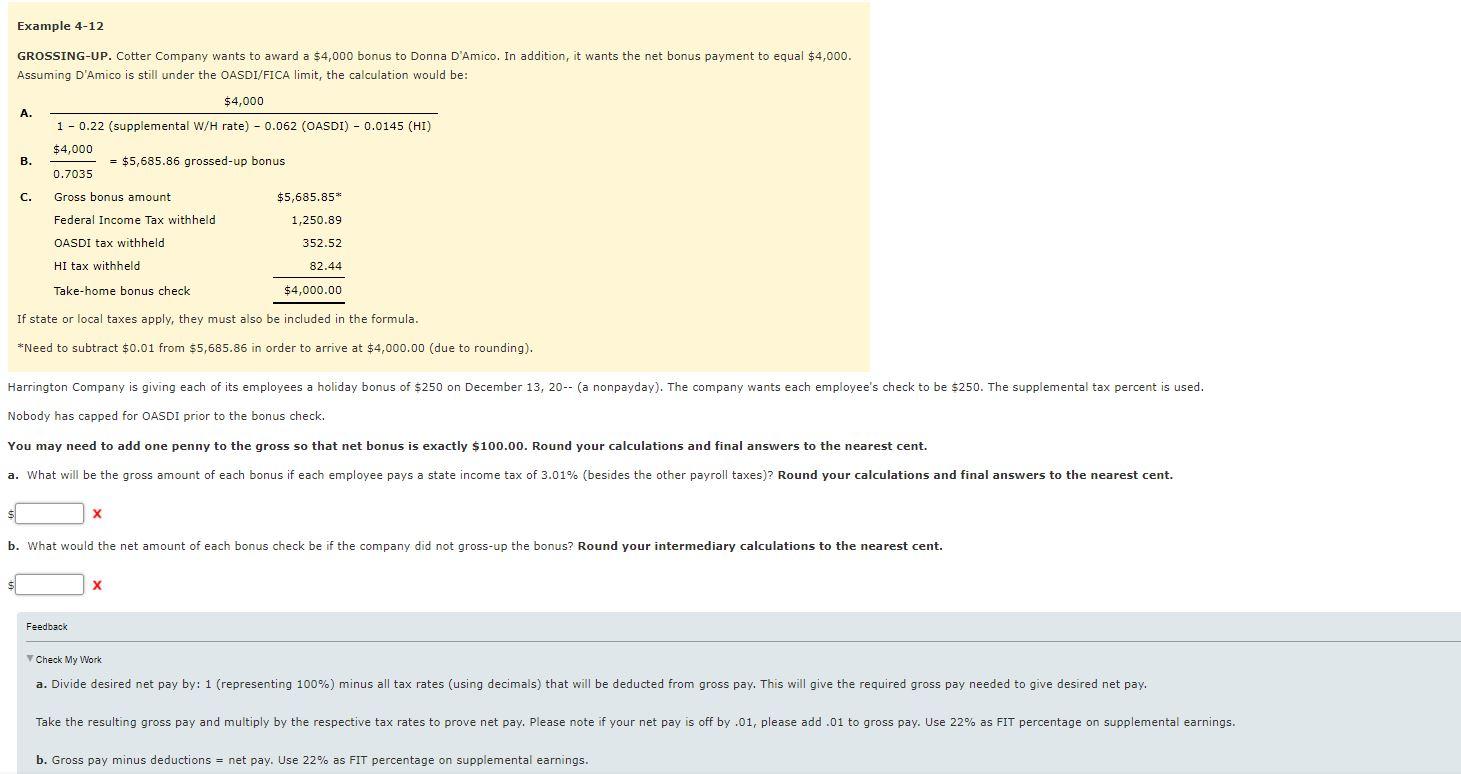Harrington Company is giving each of its employees a holiday bonus of $250 on December 13, 20-- (a nonpayday). The company wants each employee's check to be $250. The supplemental tax percent is used.
Nobody has capped for OASDI prior to the bonus check.
You may need to add one penny to the gross so that net bonus is exactly $100.00. Round your calculations and final answers to the nearest cent.

Example 4-12 GROSSING-UP. Cotter Company wants to award a $4,000 bonus to Donna D'Amico. In addition, it wants the net bonus payment to equal $4,000. Assuming D'Amico is still under the OASDI/FICA limit, the calculation would be: $4,000 A. 1 -0.22 (supplemental W/H rate) - 0.062 (OASDI) - 0.0145 (HI) $4,000 B. = $5,685.86 grossed-up bonus 0.7035 C. $5,685.85* 1.250.89 Gross bonus amount Federal Income Tax withheld OASDI tax withheld HI tax withheld 352.52 82.44 Take-home bonus check $4,000.00 If state or local taxes apply, they must also be included in the formula. *Need to subtract $0.01 from $5,685.86 in order to arrive at $4,000.00 (due to rounding). Harrington Company is giving each of its employees a holiday bonus of $250 on December 13, 20-- (a nonpayday). The company wants each employee's check to be $250. The supplemental tax percent is used. Nobody has capped for OASDI prior to the bonus check. You may need to add one penny to the gross so that net bonus is exactly $100.00. Round your calculations and final answers to the nearest cent. a. What will be the gross amount of each bonus if each employee pays a state income tax of 3.01% (besides the other payroll taxes)? Round your calculations and final answers to the nearest cent. $ b. What would the net amount of each bonus check be if the company did not gross-up the bonus? Round your intermediary calculations to the nearest cent. $ Feedback Check My Work a. Divide desired net pay by: 1 (representing 100%) minus all tax rates (using decimals) that will be deducted from gross pay. This will give the required gross pay needed to give desired net pay. Take the resulting gross pay and multiply by the respective tax rates to prove net pay. Please note if your net pay is off by .01, please add .01 to gross pay. Use 22% as FIT percentage on supplemental earnings. b. Gross pay minus deductions = net pay. Use 22% as FIT percentage on supplemental earnings. Example 4-12 GROSSING-UP. Cotter Company wants to award a $4,000 bonus to Donna D'Amico. In addition, it wants the net bonus payment to equal $4,000. Assuming D'Amico is still under the OASDI/FICA limit, the calculation would be: $4,000 A. 1 -0.22 (supplemental W/H rate) - 0.062 (OASDI) - 0.0145 (HI) $4,000 B. = $5,685.86 grossed-up bonus 0.7035 C. $5,685.85* 1.250.89 Gross bonus amount Federal Income Tax withheld OASDI tax withheld HI tax withheld 352.52 82.44 Take-home bonus check $4,000.00 If state or local taxes apply, they must also be included in the formula. *Need to subtract $0.01 from $5,685.86 in order to arrive at $4,000.00 (due to rounding). Harrington Company is giving each of its employees a holiday bonus of $250 on December 13, 20-- (a nonpayday). The company wants each employee's check to be $250. The supplemental tax percent is used. Nobody has capped for OASDI prior to the bonus check. You may need to add one penny to the gross so that net bonus is exactly $100.00. Round your calculations and final answers to the nearest cent. a. What will be the gross amount of each bonus if each employee pays a state income tax of 3.01% (besides the other payroll taxes)? Round your calculations and final answers to the nearest cent. $ b. What would the net amount of each bonus check be if the company did not gross-up the bonus? Round your intermediary calculations to the nearest cent. $ Feedback Check My Work a. Divide desired net pay by: 1 (representing 100%) minus all tax rates (using decimals) that will be deducted from gross pay. This will give the required gross pay needed to give desired net pay. Take the resulting gross pay and multiply by the respective tax rates to prove net pay. Please note if your net pay is off by .01, please add .01 to gross pay. Use 22% as FIT percentage on supplemental earnings. b. Gross pay minus deductions = net pay. Use 22% as FIT percentage on supplemental earnings







